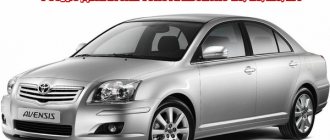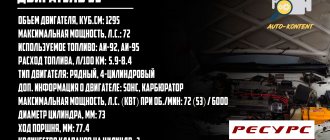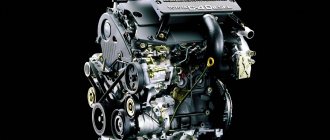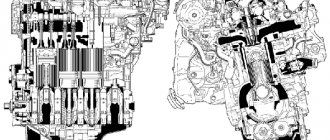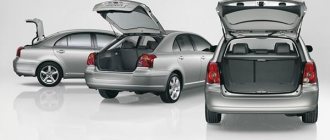AZ series power units have been installed on Toyotas since 2000. This family consists of only two engines: naturally aspirated fours 2.0 and 2.4. It is noteworthy that the AZ family of internal combustion engines were installed on more than 20 different Toyota models.
Our car enthusiasts are more familiar with the 2.0 engine, which was installed on Avernis and Avernis Verso, as well as on Toyota Camry and RAV4. That is why in this article we decided to consider the 2.0 1AZ-FSE engine model, which was removed from the 20003 Toyota Avernis. This engine variation has an interesting difference - direct injection, as indicated by the FSE marking.
By visiting our YouTube channel, you can see with your own eyes and in great detail the complete disassembly of this power unit.
Do you need a 2.0 engine for your Toyota? You can easily find the model you need in our company’s catalog.
The AZ family was developed on the basis of an aluminum block, but with cast iron liners and an open cooling jacket. Classic chain version of the timing belt. An interesting feature is that there are no hydraulic compensators in the valve drive.
If we compare the engine we are considering today with its “older” version, it is much simpler. For example, the 2.0 lacks oil injectors and balancer shafts. In addition, thanks to direct injection, the 2.0 internal combustion engine is distinguished by an increased compression ratio and a non-trivial cylinder head.
On the cylinder head housing there is a fuel pump driven by a special cam on the intake camshaft. In general, this is a completely normal and ordinary drive option for high-pressure fuel injection pumps.
Another feature is that the direct injection engine operates even on a lean mixture, where the fuel to air ratio is very different from the standard 14.7:1. But there is no trick here, since the fuel, during evaporation, goes straight to the spark plugs. For this we should thank the interesting shape of the piston bottoms and injection directly into the cylinders. It turns out that a standard stoichiometric mixture is formed right at the spark plug. True, it is still very depleted. At low load it is 40 to 1, and at medium load it is 25 to 1.
Reliability and “sores” of the 1AZ-FSE gasoline engine
The power unit in question has two engineering problems: a huge appetite for oil and a problematic cylinder block. But its shortcomings do not end there. Due to the fact that the engine uses an atypical injection system, it sometimes throws out real tricks.
Most often, motorists are faced with unstable engine operation and loss of traction. And the saddest thing is that there is still no universal solution to these problems. If we are talking about tripping or vibration, then most often the spark plugs, coils, or injectors are to blame. But there are situations when diagnostics show that everything is fine with them, and the problem was caused by a stretched timing chain.
Have you noticed that the engine has begun to “eat” more gasoline, and traction is rapidly disappearing? The lambda probe is almost certainly broken. But this is far from the only possible reason. It is quite possible that your mass fuel flow sensor is simply clogged.
And if, while driving, the whole car shakes noticeably from vibration, most likely the issue is the wear of the right support.
By the way, the engine does not have the best fuel filter and will have to be changed after 20 thousand kilometers. A mesh filter is installed directly in the tank, which quickly becomes clogged with various debris, this affects the gasoline supply pressure, which is accompanied by an error indicating low pressure in the rail. If the grid is completely clogged, the engine may stop starting altogether, or it will begin to function with the igniter missing.
Do you need an air flow meter or ignition coils for a Toyota engine? You can easily find the model you need in our company’s catalog.
Second generation
The T250 was the first Avensis to be exported to the Land of the Rising Sun. After the discontinuation of the Camry Wagon line, the Avensis Wagon passenger car (1.8l and 2.0l engine) began to be exported to New Zealand. In England, the T250 with a 1.6-liter engine was not available for sale.
The competition for European Car of the Year 2004 ended with the Toyota Avensis being knocked out of the top three. But in Ireland in the same year, the Japanese model was recognized as the best and was awarded the Semperit prize. Many considered it the best family car. In Switzerland, in 2005, they abandoned further production of the Toyota Camry. The Avensis passenger car has become the largest sedan of the Japanese corporation, intended for sale in Europe.
In England, for example, the car went on the market in the following trim levels: TR, T180, T Spirit, T4, X-TS, T3-S, T2. A special version called the Color Collection was based on the T2 configuration. In Ireland, the car was offered to customers in 5 trim levels: Sol, Aura, Luna, Terra, Strata.
From the very beginning, the Avensis was equipped with a D-4D diesel engine, equipped with a power of 115 horsepower. Then it was supplemented with a 2.2 liter D-4D engine and the following power indicators:
Throttle valve
This unit is equipped with heating and electronic control. It is interesting that if the internal combustion engine operates on a lean mixture, the throttle is not involved in any way during its formation. It turns out that the lean ratio is controlled solely by the supplied fuel.
The throttle has no adjustment and is very easy to adapt. You will have to clean the throttle if there are problems with the car's behavior at idle. Usually cleaning helps not only to solve this problem, but also to improve the response of the motor.
Do you need a throttle valve for a Toyota engine? You will find the desired option in the catalog.
Don't drink water from your face
You have to bend your soul to say: I liked the Avensis at first sight.
The popularity of the model rests on the unlimited trust in Toyota quality. And “Avensis” almost never disappoints customers’ expectations. Design has never been Toyota's strong point. Rare successes like “Karina-E” are rather exceptions to the rule. But in recent years, the Japanese have begun to openly test customer loyalty. Like, how ugly can a car be for them to still buy a Toyota?
It’s clear why the shapeless and flabby, like a jellyfish, previous Camry sold successfully. When a Japanese prestigious business-class sedan costs half as much as an Audi A6 and a BMW Five, you won’t break down.
But why does the equally unattractive Avensis take a leading position in the middle class? Equal in price - the sea. Even if we consider only Japanese classmates, the Accord and the Six against its background are like fashion models from the catwalk. At the same time, few people doubt the quality of Honda and Mazda.
Of course, the Avensis has a strong trump card - ride comfort. Like many Toyota models, in terms of smoothness and sound insulation, it gives the impression of a more expensive car in a higher class. And yet the main reason for the popularity of the Avensis is the magic of the Toyota emblem. In Russia, it affects buyers like the gaze of a boa constrictor on rabbits. Is a boa constrictor cute?
Almost everyone has Russian registration
The vast majority of used Avensis cars were once sold new in Russia. In America, where second-hand goods are cheap, the model was not sold, and today it is unprofitable to bring a middle-class car from expensive Europe.
We sold a sedan and station wagon (in Europe there was also a liftback), equipped with gasoline engines ranging from 1.8 to 2.4 liters. The Japanese fundamentally did not supply diesel engines with direct injection of the D4-D family to Russia due to the low quality of our fuel.
And in the basic configuration, “Russian” cars are richly equipped. Even the budget version of the 1.8-liter sedan, which appeared in 2005, contains almost everything you need. Well, the top modifications are “packed” to the maximum – right down to xenon headlights and leather interior.
Despite the fact that it is assembled in England using European components, the Avensis turned out to be reliable and durable in the Japanese way. In any case, to date the European origin of the car has not yet shown its worst side.
The few “jambs” that the Avensis has are also characteristic of Japanese-made models. Almost all of them are little things like chrome peeling off plastic decorative parts from road salt. However, there is one very serious problem, and it is related to the engine. It is not at all necessary that you will encounter it. But if it does happen.
“One and Eight” – lottery
If you choose by characteristics, even the basic 1.8-liter engine with a capacity of 129 horsepower should be considered sufficient for the Avensis. This is one of the few engines of this size that can even cope with an automatic transmission in a middle-class car.
Although the 2-liter 147-horsepower engine is, naturally, even better. With it under the right pedal there is absolutely no feeling of budget. This motor has exactly as many capabilities as you need.
In 2004, a year after the start of production of the current Avensis, a 163-horsepower “two and four” appeared. It is combined only with a 5-speed automatic transmission and performs noticeably better than its 2-liter brother. However, such an Avensis cost almost as much as a Camry when new, so used 2.4-liter cars are not cheap.
From a reliability point of view, almost all of these engines could be called ideal. There are no serious malfunctions characteristic of them. All have an “eternal” chain drive, and although the valves are adjusted by selecting the thickness of the pushers, in fact they do not require adjustment until at least 200 thousand. Even engines with direct injection of the D4 family (volume 2.0 and 2.4 liters) did not live up to the initial fears.
If you do maintenance on time, change spark plugs and preventively wash injectors with an air flow meter, drive and drive - they won’t break down. The only peculiarity is that they operate harshly, with increased vibrations at idle. But this is precisely the feature.
Alas, the idyllic picture is spoiled by the 1.8-liter engine of the ZZ series (the same ones, 1.4 and 1.6 liters, were installed on the previous Corolla). Some batches of engines in this series suffered from increased oil consumption. Usually “Toyota” units do not eat it at all, but here after 50,000 km the consumption gradually increases to 1–2 l/1000 km. In this case, opening the engine reveals severe wear of the cylinder-piston group.
Only in April 2005 did they change the design of the rings and pistons, and also increase the volume of oil poured. If you buy an early production car that has driven more than 100,000 miles, has no blue smoke coming from the pipe, and has normal oil consumption, the problem is either already resolved under warranty or does not exist at all. But vehicles with a mileage of 50,000–70,000 km are at risk. Perhaps the owner felt the first signs of impending trouble and “resets” the car precisely for this reason.
If increased oil consumption is detected, you will have to replace the pistons with rings (which rarely helps) or the short block - actually the engine assembly, only without the head. In monetary terms, this ranges from $2,000 to $5,000 with a higher likelihood of maximum costs.
To avoid spending such a sum, the 1.8-liter engine should be diagnosed especially carefully before purchasing. Better yet, buy a 2-liter car - these are only a little more expensive.
“Mechanics” or “automatic”
This is purely a matter of your personal preference. In terms of reliability, there are no complaints about any of the boxes. “Mechanics” in any case is 5-speed, and in the “automatic” there can be 4 or 5 gears (with a 2.4 liter engine). In a manual transmission, it is advisable to change the oil after 40,000 km, in an automatic transmission - after 80,000 km. The clutch lasts an average of 150 thousand.
Investments – minimum
There were some complaints about the chassis of early Avensis cars. In particular, the upper wishbones of the rear suspension were knocking. On 1.8-liter cars equipped with electric power steering, the steering column rattled on bumps. On 2-liter engines with power steering, rotation of the steering wheel could be accompanied by extraneous sounds. However, both the levers, the steering column assembly (1.8 l), and the rack (2.0 l) were replaced under warranty.
In general, the chassis of the Avensis is surprisingly strong. If you take a car with a mileage of about 100,000 km, which has been driving on our roads all the time, in the foreseeable future you will only have to change the shock absorbers, stabilizer struts and one or two steering rods. Most expensive suspension and steering parts (levers, rack, etc.) last more than 150,000 km. Considering that at this run they are still quite alive, they will probably go all 200 thousand and even more.
That is, the main expenses for repairing the chassis should fall on the share of the third owner, and the second one can get by with minimal investments. Such luxury is possible for very few cars.
As on the Corolla, only the brake pads and discs are not very durable, which are enough for a maximum of two sets of pads. However, against the backdrop of the enviable survivability of all other details, this is quite acceptable. In addition, during maintenance it is necessary to check the mobility of the brake calipers and clean them of dirt. However, even if they start to jam, they can be revived with the help of a repair kit.
Plastic manifold
In general, the AZ family was among the first Toyota engines to be produced with a plastic manifold. And to the surprise of many, it does not cause headaches. True, in the first years of production it was not of particular quality, which was manifested by excessive noise when the internal combustion engine was operating at low speeds. But the error was quickly identified and an improved collector began to be produced.
4 years after the engine was released, the load was determined by a pressure sensor. But already in 2004, power units began to be equipped with a flow meter.
Engine Toyota 3S-FE/FSE/GE/GTE 2.0 l.
- Engine capacity, l. - 2.0.
- Power, hp - Up to 260.
- Fuel used, gasoline - 95, 98.
- Consumption, l/100 km, highway – mixed. — city — 8 – 9.5 – 13.
- Number of cylinders - 4.
Toyota 3S is the most popular engine in the S series. It was produced from 1984 to 2007 inclusive. Timing belt drive. Modifications:
- 3S-FE is the base engine of the 3S series. Injector fuel injection. It runs on 92 gasoline, but 95 is better. Compression ratio is 9.8. There are two ignition coils. Power from 115 hp up to 130 hp depending on environmental requirements. The motor was produced from 1986 to 2000.
- 3S-FSE (D4) - the first engine with direct fuel injection. Power 150 hp Gas distribution of the VVTi system. Electronic throttle drive, EGR valve is provided for afterburning of remaining fuel in the exhaust gases. Compression ratio 9.8. power 150 hp 3S-GE is an improved version of 3S-FE. The cylinder head mechanism has been improved (with the participation of engineers from Yamaha). Execution options:
- 3S-GE Gen 1 - the mod was produced until 1989. Power from 135 hp up to 160 hp More powerful engines were equipped with an intake manifold with an adjustable window and T-VIS systems;
- 3S-GE Gen 2 - the second version of the GE motor, produced until 1993. The T-VIS system manifold has given way to ACIS. The compression ratio was increased from 9 to 10, power - to 165 hp;
- 3S-GE Gen 3 - the third mod, produced until 1999. The manufacturer changed the distribution mechanism, increased the compression ratio to 10.3 and power to 180 hp;
- 3S-GE Gen 4 BEAMS/Red Top is the fourth generation powerplant. Production began in 1997. Valve timing with VVTi adjustment, compression ratio increased to 11.1. The windows of the intake and exhaust channels were enlarged. All this made it possible to produce a mechanism with a power of 190 hp;
- 3S-GE Gen 5 is the latest change from GE. Variable phases on both distribution shafts - Dual VVT-i. Power 200 hp
3S-GTE. In parallel with the GE series, they were modified with a turbocharger - GTE:
- 3S-GTE Gen 1 - the first version, produced until 1989. A CT26 turbine was installed. Engine power 185 hp;
- 3S-GTE Gen 2 - the second modification. The turbine received a double casing and increased supercharging. Power plant power up to 220 hp. The mod was produced until '93;
- 3S-GTE Gen 3 - third version. A CT20b turbine was installed. Power was increased to 245 hp. The engine was produced until 1999;
- 3S-GTE Gen 4 is the latest version of the 3S series. The exhaust system has been improved. Power increased to 260 hp.
The series ceased production in 2007.
It is worth noting that despite its overall technology, the first engine with direct injection earned a reputation as a capricious unit. The 3S-FSE engine was installed from 1997 to 2003, when it was superseded by the new 1AZ-FSE.
In general, the power units of the modifications under consideration have a decent service life. With skillful use, you can drive 400,000 km. and more.
Tuning allows you to increase power up to 700 hp.
"Swirl" dampers
A damper block is located between the manifold and the cylinder head. At low loads they block 50% of the intake channels. Due to this, the air flow is seriously accelerated and a vortex is formed, due to which the fuel-air mixture is mixed.
The dampers are made of very high quality, so they do not cause headaches, but they are driven by a vacuum drive. Based on this, it is worth understanding that an electric valve is installed on the vacuum line, which is responsible for the operation of the entire unit. And sometimes you may encounter a situation where it breaks. It’s just impossible to track this through the operation of the car, fortunately an error appears indicating a malfunction, but this is only in a situation where its electronic component is faulty.
Salon
Avensis T22 has a fairly spacious interior. Its capacity is designed for five people. Sound insulation is quite mediocre.
Avensis 1998 was equipped with seats with velor fabric upholstery; later, after restyling, leather interiors became available.
The cars have a practical and spacious trunk with a volume of five hundred liters. The dashboard is equipped with all the necessary signal lamps and has a neat appearance. The steering wheel is covered with leather.
injection pump
The fuel injection pump of the internal combustion engine in question generates pressure in the range of 80-130 bar and directs it to the ramp. According to the design, the gasoline brine is completely identical to the diesel one: it is equipped with a pressure sensor and a spare valve responsible for releasing gasoline when the pressure exceeds the permissible limit.
In general, the engine has a good fuel injection pump, which does not cause any problems. Especially if you drive on normal fuel, low-quality gasoline can lift up the plunger. Development on its pusher is extremely rare.
The only vulnerability of the fuel injection pump is the rubber seal with a spring ring. If wear occurs, fuel may enter the oil. This will affect the operation of the pump, which will lead to the fact that the idle speed will begin to float, and the engine may stall if there is over-throttle.
By the way, in the early 2000s, when this engine first appeared and began to be installed on Toyota Avensis, the car was massively recalled and the check valve through which gasoline penetrated into the oil was changed.
Did you need to purchase a fuel injection pump for a Toyota power unit? The required model can be found in our company's catalogue.
Toyota Avensis owner reviews
- Review
- Prices
- Characteristics
- Photo
- Video
- Reviews
All the disadvantages of Toyota Avensis 3
➖ Stiff suspension ➖ Quality of finishing materials ➖ Sound insulation
pros
➕ Spacious trunk ➕ Reliability ➕ Spacious interior (no central tunnel at the rear) ➕ Design
The advantages and disadvantages of the Toyota Avensis 3 were identified based on reviews from real owners. More detailed pros and cons of Toyota Avensis 1.8 and 2.0 with manual and CVT can be found in the stories below:
Owner reviews
I have been using the car since August 2011. The mileage is 61,000 km. Until now, I have only changed consumables. Even the battery is original and has never been recharged. The machine never failed in any frost. Considering that I live in the north, this is a serious indicator. To be fair, it must be said that it is in a garage, but the garage is cold.
Great exterior. Reliable in operation. Consumption in summer: highway - 7 l, mixed - 9 l, winter - 12 l (with warm-ups). The interior warms up perfectly in winter, the seal is good, it retains heat, and in summer dust does not penetrate into the interior.
The noise insulation is good and does not interfere with conversation on the highway. Dual-zone climate control works flawlessly. There are no complaints about the variator. AI-92 eats without problems. The sport mode is a good assistant on the highway when overtaking. The electronics did not fail.
But the suspension is a bit harsh, I would like it to be softer, for example, like the Camry. There are not enough additional winter options (heated steering wheel, windshield). I personally miss cruise control on the highway.
Yuri Naletov, review of Toyota Avensis 1.8 (147 hp) CVT 2011
Fuel pressure sensor
It is very common for the sensor to start acting up and producing erroneous pressure data, which leads to problems starting the car. There are also situations when the sensor shorts and the electronic control unit simply stops working. In such a situation, the engine refuses to start, and diagnostics cannot reach the ECU. You can cope with the problem purely by chance, or by knowing about the sensor malfunction. The cost of the original spare part starts from $150, so many car enthusiasts prefer to take it from a disassembly.
Filter by brands and models all comparison tests
- A Acura
- Alfa Romeo
- Alpina
- Alpine
- Aston Martin
- Audi
- Aurus
- B Bajaj
- Bentley
- BMW
- Brilliance
- Bugatti
- BYD
- C Cadillac
- Caterham
- Changan
- Chery
- CheryExeed
- Chevrolet
- Chrysler
- Citroen
- Daewoo
- Daihatsu
- Dartz Motors
- Datsun
- Detroit Electric
- DFM
- Dodge
- D.S.
- FFAW
- Ferrari
- Fiat
- Ford
- Foton
- G GAC
- GAZ
- Geely
- Genesis
- GMC
- Great Wall
- GTA Motor
- H Hafei
- Haima
- Haval
- Hawtai
- Hennessey
- Honda
- Hummer
- Hyundai
- I Icon
- Infiniti
- Iran Khodro
- Isuzu
- JJAC
- Jaguar
- Jeep
- K KIA
- Koenigsegg
- L Lada
- Lamborghini
- Land Rover
- Lexus
- LIFAN
- Lincoln
- Lotus
- Luxgen
- M Marussia
- Maserati
- Maybach
- Mazda
- Mazzanti
- McLaren
- Mercedes-Benz
- MG Cars
- MINI
- Mitsubishi
- N Nissan
- Opel
- P Pagani
- Peugeot
- PGO
- Porsche
- Proton
- Q Qoros
- Ravon
- Renault
- Rolls-Royce
- S Saab
- Samsung
- SEAT
- SeAZ
- Skoda
- Smart
- SsangYong
- Subaru
- Suzuki
- T TagAZ
- Tata
- Tesla Motors
- Toyota
- Troller
- TVR
- V Volkswagen
- Volvo
- WW Motors
- Wiesmann
- Z ZAZ
- Zotye
- ZXAuto
- Yo Yo-auto
- 4Runner
- Alphard
- Auris
- Avalon
- Avensis
- Camry
- Celica
- C-HR
- Corolla
- Corolla Cross
- Crown
- FJ Cruiser
- Fortuner
- GR 86
- GT 86
- Harrier
- Hiace
- Highlander
- HiLux
- IQ
- Land Cruiser
- Land Cruiser Prado
- Prius
- RAV4
- Sienna
- Sienta
- Supra
- Urban Cruiser
- Venza
- Verso
- Verso-S
- Vios
- Voxy
- Yaris
- Yaris Cross
showing 1 - 5 of 5 tests
Injectors
They are mounted on the ramp and do not have fuel lines. The injectors have 2 operating options: fan injection and narrow spray. The second option is used at the end of the compression stroke, so that gasoline enters the recess on the piston and is directed to the spark plug. This allows you to create a heterogeneous and lean mixture, on which the power unit operates at low speeds.
Interestingly, the injectors are controlled by a 100-volt signal generated in a separate amplifier connected to the electronic control unit. The cost of the injectors is appalling, about $350 apiece.
Most often, injectors suffer due to low-quality gasoline and problems with fuel combustion in the cylinders. This is where we get to the most interesting part. It’s worth starting with the fact that even removing the nozzle is very difficult. The problem is that the plastic around the winding very quickly loses its properties and becomes brittle. This leads to the fact that strong pressure literally breaks the nozzle. Therefore, you have to resort to a special puller that clings to the metal part of the nozzle.
Another problem is that many cleaning products are harmful to these injectors and cause them to leak. By the way, if you look at the instructions for this engine, you will see that Toyota engineers completely prohibit cleaning the injectors.
Winding failure is another common cause of injector failure. This is easy to understand: the engine starts to have difficulty starting and an error appears. The injector control unit is of high quality, but as the mileage increases, the chance of its breakdown increases.
3ZR-FAE
The unit in question has been assembled in US factories since 2008. Its power is 152 horsepower, the peak torque reaches 193-195 Nm. The in-line 4-cylinder 2.0 3ZR-FAE complies with the EURO 5 environmental class. The optimal brand of gasoline for it is AI-95, but operation at ninety-second is also allowed. A suitable oil is 5W20, but the owners of this engine advise using a higher viscosity lubricant for less consumption. For 100 kilometers it takes about 10 liters of gasoline. CO2 emissions into the atmosphere are 145-225 g/km. The 2.0 3ZR-FAE accelerates the Avensis to 100 km/h in 9.3 seconds.
Unlike its predecessors, this engine was able to avoid such problems as high oil waste. Some even call this unit the best powerplant ever installed in a Toyota Avensis. At the same time, it is not without its shortcomings. These include, as before, chain stretching, pump leakage and unnecessary noise while driving.
Phase shifter
This part of the VVT-i system is located on the intake camshaft. In general, this is the most common vane phase regulator, which on AZ series engines is responsible for rotating the camshaft within 50 degrees. It is controlled by a conventional electro-hydraulic valve, nothing special.
Unfortunately, it is not of particular quality; it quickly wears out and breaks, fortunately this is easy to understand by the crackling sound of the clutch. Of course, there will also be problems with phase regulation. The concern made many attempts to improve phase shifters, but was not particularly successful in this.
There is no filter mesh on the control valve spool, since it is installed separately in the lower part of the engine, not far from the power steering pump. It is recommended to clean it from time to time, otherwise problems will arise with the phase shifter and the valve itself over time.
First generation
Even from the start, Avensis was given a choice of 3 gasoline engines with a volume of 1.6, 1.8 and 2.0 liters or a 2.0 liter turbodiesel. Toyota Avensis engines were in no way inferior to other cars in their class. There were three types of bodies: sedan, hatchback and station wagon, which was essentially a version for the Japanese market of the 2nd generation Toyota Caldina.
The entire line was distinguished by excellent assembly, impeccable reliability, a comfortable and spacious interior, a smooth ride, and numerous additional equipment. The model underwent a certain restyling at the very beginning of the third millennium. Valve timing adjustment systems were installed on the engines.
Satellite navigation has become a standard option in all car brands. The line was complemented by the Avensis SR sports car, equipped with a two-liter engine, sports suspension, and a tuning package. However, sales of first-generation passenger cars left much to be desired.
The list of motors, their volume and power is as follows:
The length of the car was 4600 mm, width - 1710, height - 1500 mm. All this with a wheelbase of 2630 mm.
The large MPV-class Avensis Verso, which appeared on the market in 2001, could accommodate seven passengers. It was equipped with an exclusive 2.0 liter engine option. Its platform anticipated the second generation cars. In Australia, this model was simply called Avensis, and it was awarded the status of the best passenger car among those intended for transporting passengers. No other options were available here.
Timing drive
The drive uses a classic single-row chain, irrigated from a special nozzle. Of course, a hydraulic hydraulic tensioner is used here.
As practice shows, the chain is quite capable of lasting about 200 thousand. If it is stretched, it is easy to understand by a loud ringing sound, errors in valve timing and random misfires. It's interesting that errors can pop up all at once.
Did you need to purchase a cylinder head for a Toyota engine? You will find the desired model in our company's catalog.
European middle class
Toyota presented the Avensis model to the general public back in 1997; it was designed to replace the obsolete Carina E. Avensis occupied the D-segment (middle class) in the Japanese auto giant's lineup. High build quality, modern design and excellent technical characteristics allowed this model to be sold all over the world in huge quantities and receive many positive responses from professionals. The production continued for more than twenty years, until in 2018 Toyota announced the cessation of production. As a result, as many as three generations of Avensis with different body options, as well as a wide range of power plants, managed to see the light of day.
cylinder head
A structural problem with the entire family of AZ engines is the frequent failure of the threads of the cylinder head mounting bolts. Most often this happens due to slight overheating. This has many consequences, each worse than the other: “lifting” of the cylinder head, failure of the joint seal, leakage of antifreeze into the cylinders and supply of gases into the cooling channels.
The company's management agreed that the problem was structural and replaced the units for years. But already in 2006, a spacer was added to the cooling system, which improved the circulation of antifreeze and heat dissipation.
To repair a non-warranty case, the resourceful Japanese released a set of threaded bushings.
What engines did Toyota Avensis have?
To replace the popular Carina E, the Toyota Avensis appeared in 1997 in Derbyshire (Great Britain) at the enterprise of the Japanese manufacturer.
This model had a completely European appearance. Its length was reduced by 80 millimeters. The car has attractive aerodynamics for this class. The drag coefficient was 0.28. Three things made the car popular:
Toyota Avensis engines met the requirements of the time. The car was launched on the market as a more current model than the Carina E and Corona. The series quickly proved its success in Europe. For some time, this brand has been improving its technology, efficiency and power indicators, as well as size during production. Soon it was able to compete with famous rivals (Ford Mondeo, Skoda Superb, Mazda 6, Opel / Vauxhall Insignia, Citroen C5, Volkswagen Passat, Peugeot 508 and others).
The new product has become available to customers in the following body options:
On the Japanese market, the Avensis brand is a large sedan sold through the corporation's dealerships. It is not sold in North America, but Toyota's "T" platform is shared across several models.
Pistons
The 2.0 internal combustion engine in question has slightly longer piston skirts than its 2.4 counterpart. The pistons of a direct injection engine also have a small recess in the bottom of the piston, which is responsible for supplying gasoline to the spark plug.
A well-known problem is that engines suffer from wear of the cylinder-piston group, usually this occurs at 200 thousand. To breathe new life into the engine, you will need to change the piston rings and seals. But if the cylinder measurement shows wear or ellipse, get ready to spend money on a new block/engine. Of course, you can try to spend capital, although it costs more. With a significant ellipse of the cylinders, the power unit knocks the pistons loudly.
By the way, internal combustion engines with an improved block began to actively “eat oil”. The piston rings are to blame for this.
Power unit 7A-FE 1.8 l.
- Engine capacity, l. - 1.8.
- Power, hp - 120.
- Fuel used, gasoline - 92.
- Consumption, l/100 km, highway – mixed. — city — 4.23 — 5.3 — 7.2.
- Number of cylinders - 4.
- Power system - Injector.
The Toyota 7A unit differs from the base 4A by increasing the piston stroke to 85.5 mm. Depending on which countries the car was exported to, the power was set from 105 to 120 hp.
If you have a choice, it is better not to take the reduced power version of Lean Burn.
The engine is reliable when used correctly. Particular attention should be paid to valve adjustment.
In 1998, they began to produce a replacement - the 1ZZ engine, its characteristics and features are presented below.
Crankshaft desaxing
The engine has a forged crankshaft, which is offset by 10 mm relative to the lines along the cylinder axis. Thanks to this, it was possible to reduce the pressing force of the piston skirt to the cylinders, which reduces their wear.
Do you want to buy a motor for Toyota Avernis? You can easily find the model you need in our company's catalog.
Using these links, you can check the availability of specific Toyota models at the disassembly site, and, if necessary, buy spare parts from them.
Third generation
In the main configuration, the car has HID (bi-xenon) headlights, cruise control for adaptation, and an AFS lighting system. Standard equipment also means 7 airbags. Active front head restraints are designed in such a way that they can reduce the risk of injury in the event of an accident. There are brake lights that go off during emergency braking.
The course stability system, by distributing torque to the steering wheel, helps the owner control the car. The pre-crash safety system is an additional option with two subsystems. Safety for adult passengers, according to the conclusion of the Euro NCAP committee, is ninety percent.
The station wagon with a 2.0-liter four-cylinder engine is equipped with a continuously variable transmission and has been supplied to Japan since 2011.
For Avensis passenger cars, there are 3 types of diesel engines, and the same number of gasoline engines. The new engines were more efficient than before.
Toyota tested innovative gas distribution technology on engines belonging to the ZR series. The engines are sold together with a manual transmission (six-speed). Those of them with a volume of 1.8 l, 2.0 l and running on gasoline are available to buyers with a continuously variable variator. The D-4D engine with a volume of 2.2 liters and a power of 150 horsepower is sold with a six-speed automatic transmission. Toyota Avensis models are good; Which engine is better can be found out by comparing them in terms of power and volume.
With a wheelbase of 2700 mm, the length of the car is 4765, width – 1810, and height – 1480 millimeters. The most significant drawback of the engines on the Toyota Avensis is their disposability. In practice, this is expressed in the establishment of only one repair size for the crankshaft of the 1ZZ-FE engine (Japanese production only). It is impossible to overhaul the cylinder piston block, as well as replace the liners.
Source
2C-TE
The two-liter diesel engine 2C-TE took only 3 years to assemble. The engine was installed only on the pre-restyling version of Avensis for the European market. A power unit with a pre-chamber, a single-shaft SOHC cylinder head, a belt in the gas distribution mechanism drive, no phase regulators, as well as hydraulic compensators, but there is a turbine. The cylinder block is in-line cast iron, the head is aluminum 8-valve.
Owners of Toyota Avensis with 2C-TE under the hood usually complain about:
- the appearance of cracks in the cylinder head as a result of engine overheating;
- cracking of valve seats is one of the most common engine problems;
- cracking of the air duct tube - dust enters the chamber;
- TNDV Denso - often breaks down, rarely repaired;
- timing belt breaks, which leads to breakdown of the power unit.
What is the service life of the Toyota Avensis engine? At best, you should count on 240 thousand km. Much depends on the style of operation of the car and the quality of service.
